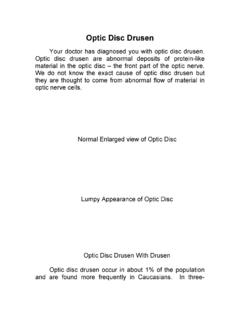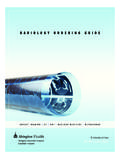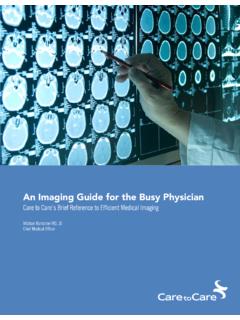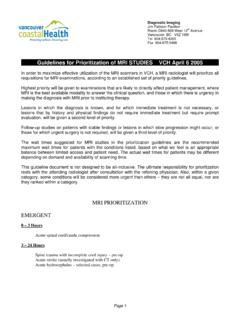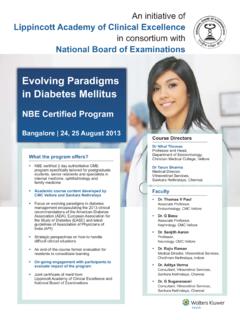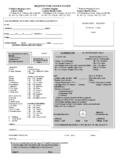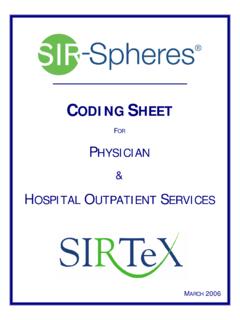Transcription of Basic Abdominal Sonographic Anatomy and Protocol
1 Basic Abdominal Sonographic Anatomy and Protocol Sandra Hagen-Ansert, , RDMS, RDCS ultrasound Education Specialist and Clinical Consultant Charleston, South Carolina Table of Contents 1. Objectives 2. Introduction 3. Patient Preparation and Position for the ultrasound Examination 4. Transducer and Instrumentation Selection 5. Introduction to Sonographic Abdominal Anatomy 6. Basic Scanning Techniques & Patient Position 7. General Abdominal ultrasound Protocol 8. Documentation 9. Conclusion 10. Bibliography 11. CME Quiz Objectives Know the organs in the Abdominal cavities Learn how to recognize Abdominal structures in multiple planes Know the correct orientation of an ultrasound image Understand the criteria for a quality ultrasound image Recognize the sectional ultrasound Anatomy in the transverse and longitudinal planes Understand the Basic Abdominal Protocol Describe the patient preparation, transducer selection, patient position, and images that should be obtained for all Abdominal and soft tissue structures Introduction The purpose of this program is to provide the reader with a introduction into the Basic Abdominal scanning techniques and protocols utilized in the general ultrasound department.
2 This is the second of a series of Basic articles that focus on the concepts of sonography beginning with Sonographic Abdominal Anatomy , instrumentation and transducer selection, Basic scanning techniques and patient positions, patient preparation, and finally the general Abdominal ultrasound Protocol . Basic gynecology and obstetrics will be covered in a separate program. This program would be appropriate for an entry-level sonography student, medical student, or radiography student. It is not unusual for the experienced sonographer to hear the phrase, "I didn't realize it would be this difficult to create make an ultrasound image - you make it look so easy!" The state of the art of ultrasound demands a high degree of manual dexterity and hand-eye coordination, and the ability to conceptualize two-dimensional information into a three-dimensional format. Coupled with this ability, the sonographer must also possess a background knowledge of Anatomy and physiology, pathology, instrumentation, how to avoid ultrasound artifact production, and transducer characteristics.
3 ultrasound equipment today is so sophisticated that it demands a much greater understanding of the physical principles of sonography to produce quality images. The beginning sonography student will soon learn that the "art of scanning" cannot be acquired from reading a textbook; the one-on-one individual "hands-on" training in a clinical atmosphere is a critical and intregal part of the sonographer's experience in producing high-quality scans. Patient Preparation and Position for the ultrasound Examination Patient Preparation. The ultrasound examination is most effective if the patient has been NPO for at least 6 hours. This allows the biliary system to be distended and easily imaged by the sonographer. When a patient is fasting there is a a decreased opportunity for gas to accumulate within the colon; gas prohibits the passage of the sound and thus limits visualization of Abdominal structures.
4 If the patient is able to consume liquids and the pancreas is not well-visualized, the administration of 32 oz. of water may be given to fill the stomach and duodenum to better delineate the pancreas. The kidneys are best imaged when the patient is fully hydrated, therefore no patient preparation is necessary when only the kidneys are examined. Full hydration will also enable the sonographer to image the distended urinary bladder. Patient Position. The position of the patient for the general Abdominal scan is usually supine for the initial images. The patient is then rolled into various degrees of obliquity to better demonstrate the biliary system, pancreas, liver, kidneys, or spleen. If the scanning plane is oblique, the sonographer should indicate the change of position on the documented image without specifying the exact degree of obliquity. The same would apply if the patient were in a lateral, upright, or prone position.
5 Transducer and Instrumentation Selection Transducer The upper abdomen is scanned with the highest-resolution transducer possible for the size of the patient. The transducer may be a sector or curved linear array, or in many cases, a combination of the two. The transducer frequency depends on the size, muscle and fat composition of the patient. Generally a 3-MHz transducer is used on most normal sized adult patients, with variations of to MHz, depending on image resolution and beam penetration through the deeper structures in the liver. Most transducers today actually are multi-focal with multiple frequencies available in one transducer; therefore, the liver may be scanned with the lower frequency, while the pancreas and gallbladder may be scanned with the higher frequency transducer. The lower-frequency transducers are often necessary in patients with fatty infiltration or cirrhosis of the liver.
6 Instrumentation The primary controls the sonographer needs to utilize in the general Abdominal scan are the depth, time-gain compensation, overall gain, and zoom control. The depth controls the size of the overall image. This should be set so the image fills the screen without loosing information along the posterior border. Most normal adult abdomens range in size from 15 to 20 cm deep. The time-gain compensation controls individual gain pods within the image. These pods are aligned to the depth control ( if the depth is set at 20 cm and there are 10 pods, each pod would adjust the gain at 2 cm increments). The sound beam is absorbed, attenuated, and reflected as it strikes a surface; by adjusting the time-gain controls, the sonographer is able to electronically amplify the echo in a certain area so the sound will be stronger and produce a brighter echo return. The overall gain controls the amount of echoes received by the transducer.
7 It is analogous to the volume control on the radio, the higher you turn up the volume, the louder the sound. Such is the response of the overall gain control, as the sonographer increases the gain, more echoes are seen throughout the image. If the gain is set "too high" the sonographer will have difficulty in distinguishing the various gray scale interfaces. The vascular structures should be anechoic or echo-free and may be used as a control to make sure the gain is not set too high. On the other hand, if the gain is set too low, the overall image will be dark and texture patterns within the organs difficult to see. In addition to the instrument controls, the sonographer must find the best "window" on the patient's abdomen. The window refers to the area which the transducer may be angled to record the majority of Abdominal landmarks without interferance from the ribs, bowel, stomach, or lungs.
8 Introduction to Sonographic Abdominal Anatomy Sectional Anatomy The sonographer must have a working knowledge of anatomical structures with particular attention to spatial relationships within the body. Most students entering ultrasound have some Basic understanding of Anatomy . However few students have been exposed to gross Anatomy or sectional Anatomy or to all of the anatomical variations that may occur in the body. The student in sonography needs to understand not only anterior to posterior anatomical structures, but also superior to inferior, medial to lateral relationships. This is the basics of how the three-dimensional reconstruction is developed from a two-dimensional image by the sonographer. The understanding of where the organ is in relation to the transducer as well as to other anatomical structures is critical for an adequate image to be constructed.
9 ultrasound of the abdomen is generally performed in at least two image planes, transverse and longitudinal. It is not unusual for the sonographer to alter these imaging planes or change the patient position if adequate visualization is not obtained. Transverse Plane The transverse sectional images (Figures 1-4) are presented in descending order from the dome of the diaphragm to the umbilicus. The sonographer should review the relationship of each organ to it's neighboring structures as one proceeds in a caudal direction towards the umbilicus: Figure 1: AC - Transverse image at the dome of the liver shows the middle hepatic vein draining into the inferior vena cava. The homogeneous liver texture is well seen. Figure 2: AD - The right hepatic vein drains into the inferior vena cava; the liver parenchyma shows the portal and hepatic vascular structures within. Figure 3: AI - Transverse image with the transducer angled inferior, using the left lobe of the liver as an acoustic window to image the pancreas and vascular structures.
10 Figure 4: ACG - Transverse image of the pancreas and vascular structures. Longitudinal Plane The longitudinal sectional images (Figures 5-8) are presented from the midline of the abdomen to the right Abdominal border. Images of the spleen and left kidney are made with the patient in a left lateral decubitus position. Figure 5: ABV - longitudinal image of the midline of the abdomen shows the aorta with the celiac axis and superior mesenteric artery arising from the anterior wall. Figure 6: ABX - longitudinal image slightly to the right of midline shows the left lobe of the liver, ligamentum venosum, and caudate lobe of the liver anterior to the inferior vena cava. Figure 7: ACA - longitudinal scan of the left lobe of the liver, with the middle hepatic vein draining into the inferior vena cava. Figure 8: ABL - longitudinal scan over the right lobe of the liver.
